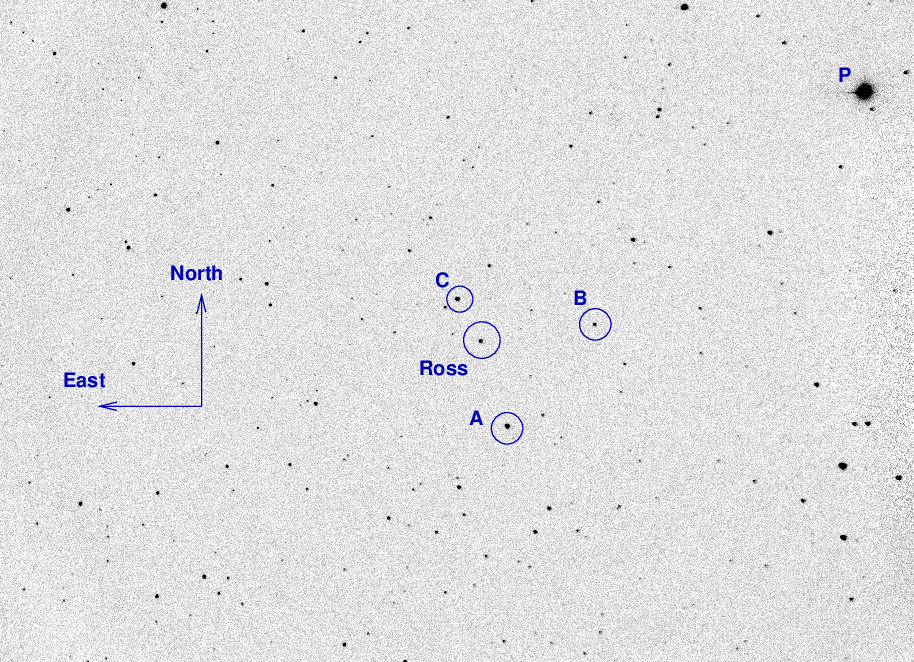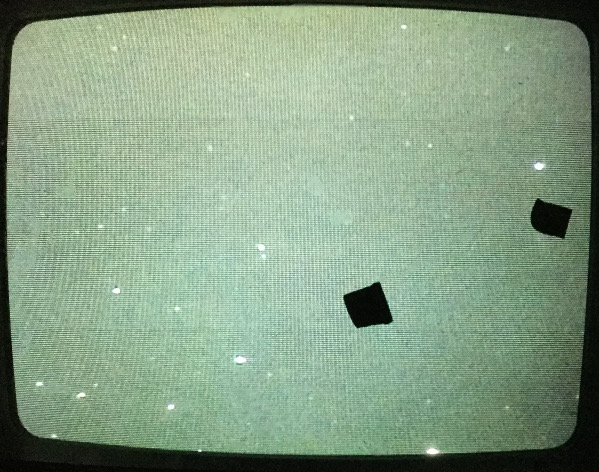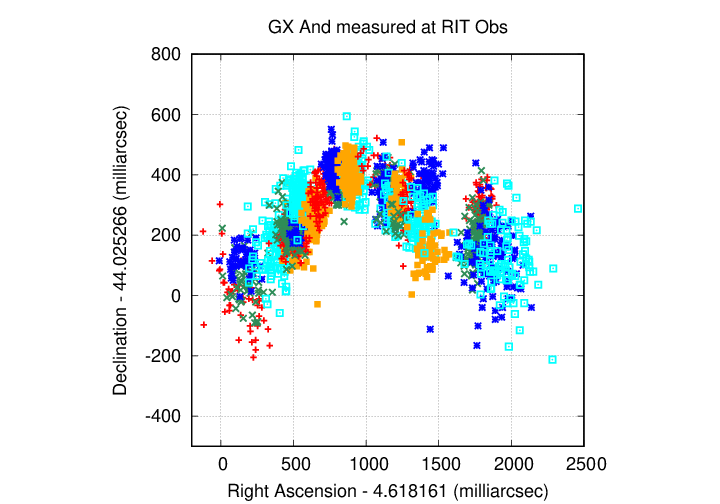
On the night of Feb 26/27, 2021, under fair conditions, I acquired images of
The Moon was bright, but the skies were clear or nearly clear. Nonetheless, the targets were low enough in the sky (between 31 and 36 degrees above the horizon) that the measurements have a very large scatter. I guess it's time to quit trying to catch them in the very early evening. I'll have to wait until May for them to rise high enough in the morning to be worth observing again.
This is one of the stars that a capstone student may study over the next year in a project involving parallax. Ross 248 is a relatively faint red star surrounded by many other stars of similar brightness, so it's a good candidate for high-precision parallax measurements.
These observations involved:
Notes from the night:
The object is (currently) near position
RA = 23:41:55.27 Dec = +44:10:06.38 (J2000)
A chart of the field is shown below. The size of the chart is about 41 x 27 arcminutes. The noisy area at right (West) is the shadow of the guider's pickoff mirror.

I've marked the location of several comparison stars.
star UCAC4 B V r ------------------------------------------------------------------------- A UCAC4 671-120730 12.617 10.689 B UCAC4 671-120688 C UCAC4 671-120749 10.987 10.663 P kappa And 4.06 4.14 --------------------------------------------------------------------------
I took a photo of the finder TV's screen when pointing to Ross 248; this could be a useful reference for the future:

The dark current was normal this evening. I took two sets of 1.5-second darks, at (5:36 and 6:10 PM local). The first set was taken when the sky was still relatively bright (before sunset), and the second when it was darker (just after sunset). The pixel values were virtually identical. Good.

The sky value decreased smoothly as the sky darkened after sunset. Fine.

The number of objects detected.

The FWHM was worse than usual, probably due to the low altitude.

Here are the positions I've measured so far. The most recent measurements (at bottom center, orange) show a big scatter due to the low altitude tonight.

Like Ross 248, GX And is a nearby (binary) star which will be the target of a parallax project in the coming year. One of the two components is bright -- about mag V = 8 -- so one must use short exposures to prevent it from saturating the detector. That may mean that this system isn't as easy to measure as Ross 248 or some others.
The object is currently close to this position:
RA = 00:18:28.4 Dec = +44:01:31 (J2000)
but it does have a very high proper motion.
A chart of the field is shown below. The size of the chart is about 41 x 27 arcminutes. The noisy area at right (West) is the shadow of the guider's pickoff mirror.

The two components of the GX And binary sit inside the box. I've marked the location of several comparison stars as well.
star UCAC4 B V r ----------------------------------------------------------- A 671-001473 9.939 9.790 B 670-001639 9.413 8.472 C 671-001509 12.712 11.421 11.001 -----------------------------------------------------------
I took a photo of the finder TV's screen when pointing to GX And; this could be a useful reference for the future:

Using the same techniques as described for earlier nights, I matched detected stellar positions to the Gaia DR2 catalog.
The target is clearly moving in the positive RA direction, as we would expect from its known (large) proper motion. The big scatter in tonight's measurements (cyan symbols at right edge of graph) is due to the low altitude.

Last modified 2/27/2021 by MWR.